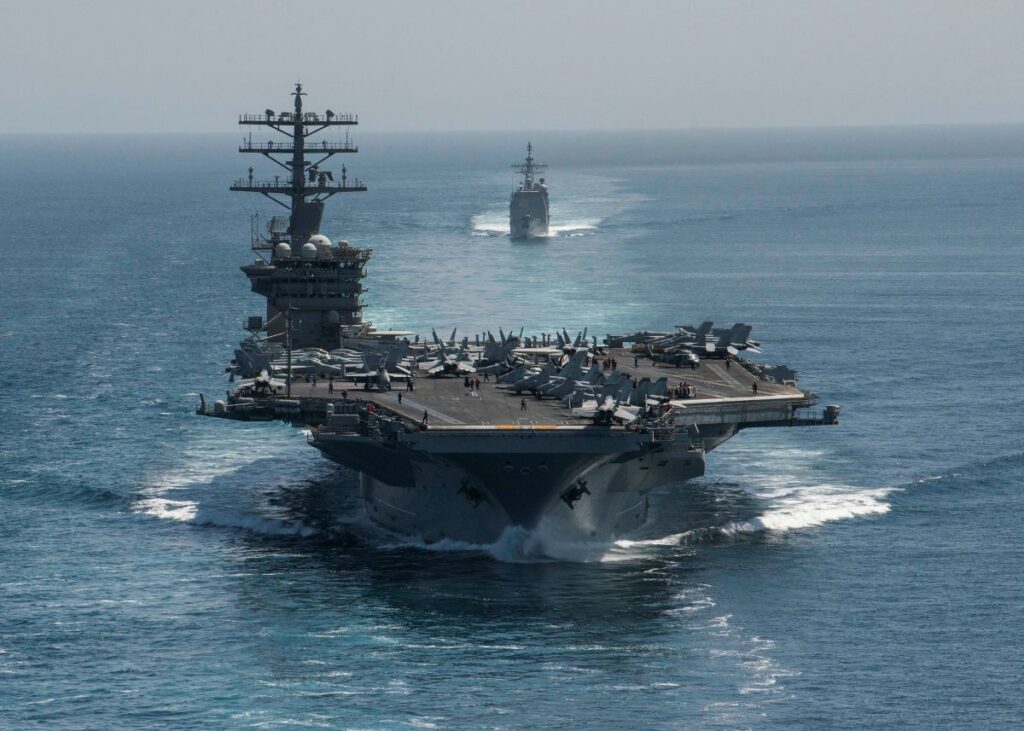In tandem with its retaliation for the recent deaths of three U.S. soldiers in Jordan, the United States launched a fresh round of attacks against Iranian-backed Houthi targets in Yemen on February 2-3. The strikes were part of an ongoing effort to protect sea-lanes in the Red Sea. Since early January, U.S. forces have launched well over 100 missiles into Yemen against the Houthis.
Maintaining open sea lanes is in the United States’ national interest. Yet, escalation today begs an important question: Is getting dragged into a broader Middle East war worth the cost to U.S. national security of protecting the principle of unfettered access to sea-lanes, both in general and in practice in the Red Sea?
The answer is “no.” War would not only bring serious economic pain and strategic overstretch to the United States, but given the unpopularity of war at home, it would also create a degree of national disillusionment that would do significant damage to the United States’ willingness to protect sea-lanes going forward. In short, too much commitment to principle today might kill the U.S. commitment to principle tomorrow. To avoid this, the United States needs to take three pragmatic steps: adopt a firm defensive strategy in the Red Sea, reduce targets for proxy attacks, and push Israel toward a ceasefire in Gaza.
The Escalation Ladder to War in the Red Sea
Recent U.S. strikes in Yemen have not deterred additional Houthi attacks nor meaningfully degraded Houthi capabilities. Instead, they’ve put the United States on an escalation ladder to a full-scale regional war.
The ladder that Washington is on in the Red Sea is much the same as the one it’s on in Iraq and Syria. In both theaters, the United States started with a defensive strategy of protecting ships/troops from incoming enemy fire. In both theaters, the United States escalated to counterforce strikes to reduce proxy capabilities and/or establish deterrence. In time, as proxy strikes continued, U.S. counterforce strikes expanded significantly (i.e., further up the ladder). The occasional, lone retaliatory strike moved to over 100 missiles against more than 70 targets in an early January attack on the Houthis and nearly the same number in Iraq/Syria recently in response to the attack on the U.S. base in Jordan, near the Syrian border.
So, if there are more deadly strikes like Jordan, what comes next? Pressure will grow on President Joe Biden to go even bigger in the elusive chase to deter further attacks. That step (which could be an attack on Iran or Houthi command-and-control structure) will bring the United States near the top rung of the ladder, dangerously close to all-out war. Iran will retaliate and proxy attacks intensify, leading to even more U.S. action, perhaps ground troops. At that point, war is on.
As history from World War I to Vietnam shows, wars often start from small conflicts (like Gaza today) that escalate through back-and-forth steps to uphold commitments (like open sea-lanes in the Red Sea). Biden says he doesn’t want war. Like other leaders in history, events beyond his control might push him there regardless.
A New Middle East War: Too Costly for the United States
For three reasons, a broader war today in the Middle East against Iran, either directly or by proxy, is not worth the cost to the United States of maintaining danger-free shipping lanes through the Red Sea.
First, a wider war would be extremely damaging to the U.S. economy. All commercial shipping through the Red Sea would probably drop to near zero and the price of oil would spike. Those two things alone would lead to a surge in U.S. inflation and global recession. The pain would be far greater than that being caused by current shipping disruptions in the Red Sea. In short, the economic costs of war exceed any presumed benefits of protecting these sea lanes today.
Second, a full-scale war with Iran or a war in Yemen against the Houthis could drag the United States into another Iraq-type war. This time, though, the United States could be fighting in a country (Iran) that is four times the size of Iraq geographically and twice the size in terms of population. Given that rebuilding Iraq proved difficult and painful, there is no reason to expect that the situation in Iran (or Yemen) would work out any better — because it would not. In the 2000s, the United States could more easily absorb strategic costs like this than today, with a revanchist Russia and assertive China now in the international system. A new Middle East war, especially with boots on the ground, would lead to U.S. strategic overstretch. Dogged resolve to protect sea lanes in the Red Sea is not worth the costs to U.S. security.
Third, the United States is too riddled with domestic political divisions over events in the Middle East to effectively fight a new war in the region. Unlike past U.S. wars (including most recently Afghanistan and Iraq), there is not the kind of broad, unifying story that this author’s research finds is necessary to generate national consensus and the buy-in required to sustain a full-scale war in the Middle East today. Eighty-four percent of Americans worry about getting pulled into a war. Young voters and the members of the progressive wing of the Democratic Party are strongly opposed to the largely unwavering U.S. support for Israel’s war in Gaza. Houthi attacks in the Red Sea (as well as attacks on U.S. troops in Iraq, Syria, and Jordan) would not be happening if not for Israel’s war in Gaza. Rather than create a rally-around-the-flag effect, a new U.S. war over protecting sea lanes would be likely to deepen these domestic divisions.
Democrats are not alone in objecting to a Middle East war. Although Republicans strongly support Israel, GOP presidential nominee Donald Trump reflected the nationalist base of the party when he complained about seemingly excessive U.S. bombing in the Middle East. Robust GOP support for a costly new war in the region is highly unlikely — especially for the “globalist” objective of protecting sea-lanes in the Red Sea that are traversed primarily by foreign, not U.S., vessels.
In general, if war occurs, there is real potential for deep national disillusionment across the United States (like after World War I, Vietnam, and Somalia (1993)) that would reinforce existing isolationist trends. Specifically, national aversion to U.S. engagement abroad to do things like protecting sea-lanes in other strategically important theaters could set in. That could do great damage to U.S. national security, coming just when the United States needs a nimble, engaged foreign policy to address new challenges in Asia and Europe.
Three Policy Steps
What should the United States do now in the Red Sea?
First, de-escalation requires reducing the number of U.S. targets in the region in order to lower the chance of Americans dying. In Iraq, Syria, and Jordan near the Syrian border, this means drawing down all troops and moving them to other, more secure regional bases. These troops are dangerously exposed, as illustrated by the more than 170 strikes against them since mid-October. The threat to the United States from the Islamic State of Iraq and Syria (ISIS) is largely gone, it ended with the collapse of the Caliphate in 2019. The cleanup mission these troops are conducting now against the remnants of ISIS can be handled by local actors, notably the Kurds, Turks, and Syrians.
In the Red Sea, comparable target reduction would involve banning all U.S.-flagged commercial vessels from the region until the current crisis passes. Many ships are already being re-routed. About 12 percent of global trade goes through the Red Sea, therefore the re-routing of U.S. vessels will create some economic — especially inflationary — pain in the United States. But that pain would pale in comparison to what a wider war in the Middle East would bring.
Second, Biden needs to return to the original defensive strategy focused on repelling incoming Houthi attacks in the Red Sea. The multilayered U.S. defense system worked effectively – minimal damage and no loss of life – prior to the start of counterforce strikes last month. Future counterforce strikes against the Houthis should become rare, limited only to attacks where sound intelligence indicates the interception of Houthi missiles will not work. Command-and-control strikes or attacks on Iran should not be on the table at all, given that a much wider war would likely follow.
A strategy too heavily weighted to counterforce strikes has several downsides. Not only do these strikes fail to appreciably degrade Houthi capabilities, but they also enhance the Houthis’ regional/domestic legitimacy and, in turn, embolden more Houthi attacks on U.S. targets. Excessive counterforce strikes also give the impression the old defensive strategy of intercepting incoming missiles does not work, which in this instance is not the case. They also convey, ironically, that counterforce strikes do not work, either, because these kinds of strikes never seem to deter Houthi attacks. These twin impressions are dangerous. They increase pressure to move up the escalation ladder toward war — if counterforce strikes do not work, it is time to go even bigger, so the argument goes.
For the commercial vessels that choose to continue using the Red Sea, the United States should, again, keep action limited to repelling incoming Houthi attacks and some convoying of these vessels through dangerous waters. More than 20 countries are partnering with the United States on this. Washington should press them (especially European allies) to do more since they have more national vessels than the United States traversing these waters.
In general, stepping back to a defensive strategy will take political grit for Biden, requiring him to block out those at home who complain doing so looks “weak.” The White House must not let the pursuit of the perfect (deterring all Houthi strikes) become the enemy of the good. Stay focused on the dangers of escalation and recognize that the current crisis will eventually pass. In short, Biden (and perhaps his successor) needs to do just enough to see things through, but not so much as to make the situation disastrously worse. Defense with limited counterforce offers the best hope for that.
Third, while defense is preferable to a counterforce strategy, it still leaves U.S. forces dangerously exposed to a potential casualty strike in the Red Sea, as recent near misses show. If that happens, escalation to a full-blown regional war will follow. For this reason, it is imperative that Washington take steps to de-escalate the current tension across the region by getting to the root cause of it: Israel’s war in Gaza.
Hamas started the current war, and Israel has a right to defend itself. But in terms of U.S. national interests, Israel’s war has gone far enough: it has brought the United States precariously close to a major regional war. The massive uptick in Houthi attacks in recent months is intended to stymie Israel’s disproportionate retaliation for the October 7 Hamas attacks. Contrary to what some might claim, Gaza and the Red Sea are undeniably connected. As the major reduction in regional proxy attacks during the November ceasefire shows, a ceasefire now would reduce tensions and offer the best chance for preventing a wider regional war from breaking out. Hence, Washington should push Israel toward a ceasefire, which might require curbing/conditioning aid to Israel. Moving Israel toward peace is, in short, best for U.S. interests.
Protecting principles central to U.S. national security over the long term sometimes requires pragmatism in the short term. Target reduction (both on land and sea), a defensive strategy centered on repelling proxy attacks, and peace in Gaza reflect that pragmatism in the Red Sea. In short, better to be realistic today in order to protect U.S. national security (including a firm U.S. commitment to open sea lanes) tomorrow.
C. William Walldorf, Jr. is a professor and Shively Family Faculty Fellow at Wake Forest University and a Visiting Fellow at Defense Priorities.




